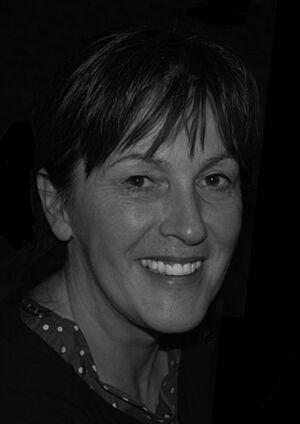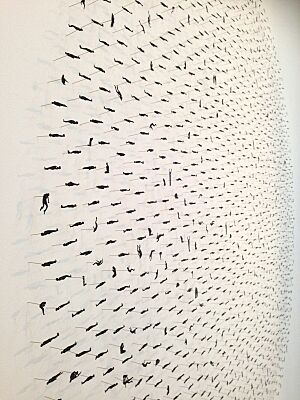Anita Groener facts for kids
Quick facts for kids
Anita Groener
|
|
|---|---|

Anita Groener, 2009
|
|
| Born |
Anita Groener
15 June 1958 Veldhoven, Netherlands
|
| Nationality | Dutch |
| Education | Mollerinstituut Moller Institute in Tilburg Hogeschool voor de Kunsten, Arnhem |
| Known for | Artist |
|
Notable work
|
The Past is a Foreign Country (2018-present);State (2013); Somewhere Else (2012); Crossing (2006) |
Anita Groener (born in 1958) is an artist from the Netherlands. She lives and works in Dublin, Ireland. Anita creates many types of art, including paintings, large drawings, films, and animations. Her art has been shown all over the world.
Anita studied art in the Netherlands. She earned her first degree in 1980 and a master's degree in 1982. She moved to Dublin in 1982. In 2005, she became a member of Aosdána. This is an important group for artists in Ireland. Her artworks are part of many collections. These include museums and banks in Ireland, the USA, and the Netherlands.
What Anita Groener Creates
Anita Groener is well-known for her drawings and paintings. These often look like drawings. Sometimes, she cuts out shapes and pins them to a wall. Her artworks can be very large.
Between 2005 and 2015, her art often showed many small figures. For example, in her 2013 show called State, she used almost 2,000 tiny figures. These figures were held with pins. When you stood back, they looked like a population on a floating planet. This made people think about how small humans are. But when you looked closely, each figure seemed important.
Anita also makes films and animations. One of her video pieces was in her 2006 show Crossings. Another was her animation Somewhere Else. This was shown at the Kilkenny Arts Festival in 2012.
Her earlier artworks were very strong and expressive. They often had human or animal-like shapes. Later, her art became more calm. It used more patterns and fewer colors. These changes showed how her art was growing.
Critics noticed these changes. They said her art showed how people communicate. It also showed feelings like separation, loss, and time passing. Anita herself has said that art is a way for her to show her thoughts. It is how she shares her experience of the world.
Teaching and Helping Other Artists
After moving to Dublin, Anita Groener quickly became accepted by other artists. In 1985, she joined the committee of the Independent Artists group. That same year, she helped bring an art show from the Netherlands to Ireland.
In 1991, she was one of only 120 artists included in The Great Book of Ireland. This was a very special book.
Anita also taught art for many years. She started teaching at the Dublin Institute of Technology (DIT) in 1982. She led the Fine Art course for two periods. She was also the head of the art department from 2004 to 2006. Anita left DIT in 2014 to focus fully on making her own art.


